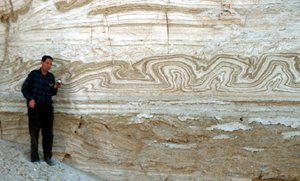Friday Rock Blogging: Evaporites
 Your erstwhile correspondent is craving salt today. Mmm, salt! Even what we typically think of as fresh water contains loads of it; if you’ve ever noticed crusty white deposits around your faucet, well, that’s the first step in a process that will eventually leave your whole bathtub coated in salt*. And by “your bathtub” I mean “Death Valley”, or for Old World readers, “the Dead Sea”.
Your erstwhile correspondent is craving salt today. Mmm, salt! Even what we typically think of as fresh water contains loads of it; if you’ve ever noticed crusty white deposits around your faucet, well, that’s the first step in a process that will eventually leave your whole bathtub coated in salt*. And by “your bathtub” I mean “Death Valley”, or for Old World readers, “the Dead Sea”.
The wacky structure in the Dead Sea photo below is known as “squiggly lamination” (or “convolute lamination” if you’re trying to sound professional). Like sand boils, it’s formed by squirts of water; unlike sand boils, the formative squirts happen when the sediment is still young and flexible. Convective or turbulent flow deforms the muck (salty muck in this case, but this happens in many sedimentary materials) just enough to make squiggles, but not so much as to disrupt its pretty layers.
* Technically, the hardness of your tap water is determined by its calcium and magnesium ion concentrations, and has nothing to do with the elements that compose table salt (sodium and chlorine, plus or minus extras if you’re a pretentious sea salt person). But of course, “salt” is also a generic term which encompasses the calcium carbonate and other crap that forms the bulk of household hard water deposits. Calcium and magnesium carbonates are typically the least soluble things present in fresh water, so their presence largely controls the amount of crap (calcite and dolomite) that precipitates out around your sink. Only with repeated cycles of wetting and evaporation will you see things like gypsum (calcium sulfate) or halite (sodium chloride, aka table salt).

Sister Earth wrote:
Friday Nature Blogging: Alders Over Lake
And do check out Greengabbro’s Friday Rock Blogging and Dope on the Slope’s Thursday Invertebrate Blogging.
Posted 13 May 2020 at 2:02 pm ¶
Friday Rock Blogging: Caliche wrote:
[…] I’ve previously rockblogged about the crusty, water-soluble minerals known as evaporites. But you don’t need open pans or puddles to produce this kind of mineral precipitate - drying out shallow soil will work just as well*. When this happens, dissolved calcium carbonates (et al.) will coat all kinds of surfaces and infiltrate all kinds of voids within the soil, from pebbles (shown here) and fractures to partly buried tree trunks. Often, repeated cycles of wetting and drying will produce a layer of evaporated gunk that cements the soil grains together just a few inches below the surface; this layer is commonly known as hardpan, or caliche. The crusty gunk itself is also called caliche; though some people reserve the term for calcium carbonates, others don’t care. Calcite is the commonest precipitate anyway. Then there are the people in India who call it kankar, which just makes me giggle. […]
Posted 27 Jan 2020 at 12:04 pm ¶
brandon blackmon wrote:
commonest is not a word. should be most common. good luck in the future with your crusty gunk….
Posted 10 Apr 2020 at 2:16 pm ¶